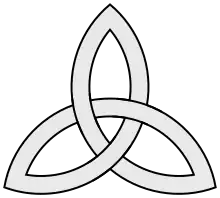
The triquetra (/traɪˈkwɛtrə/ treye-KWEH-truh; from the Latin adjective triquetrus "three-cornered") is a triangular figure composed of three interlaced arcs, or (equivalently) three overlapping vesicae piscis lens shapes. It is used as an ornamental design in architecture, and in medieval manuscript illumination (particularly in the Insular tradition). Its depiction as interlaced is common in Insular ornaments from about the 7th century. In this interpretation, the triquetra represents the topologically simplest possible knot.
History
Iron Age
The term triquetra in archaeology is used of any figure consisting of three arcs, including a pinwheel design of the type of the triskeles. Such symbols become frequent from about the 4th century BC ornamented ceramics of Anatolia and Persia, and it appears on early Lycian coins.[1]
The triquetra is found on runestones in Northern Europe, such as the Funbo Runestones, and on early Germanic coins. It bears a resemblance to the valknut, a design of three interlacing triangles, found in the same context.
Insular art
The triquetra is often found in insular art, most notably metal work and in illuminated manuscripts like the Book of Kells. It is a "minor though recurring theme" in the secondary phase of Anglo-Saxon sceatta production (c. 710–760).[2] It is found in similar artwork on early Christian High Crosses and slabs. An example from early medieval stonework is the Anglo-Saxon frithstool at Hexham Abbey.[3]
The symbol has been interpreted as representing the Holy Trinity, especially since the Celtic revival of the 19th century. The original intention by the early medieval artists is unknown and experts warn against over-interpretation.[2] It is, however, regularly used as a Trinitarian symbol in contemporary Catholic iconography.
Buddhist tradition
The triquetra has been a known symbol in Japan called Musubi Mitsugashiwa. Being one of the forms of the Iakšaku dynasty signs, it reached Japan with the dynasty's Kāśyapīya spreading technology and Buddhism via the Kingdom of Khotan, China, and Korea.
Modern use
The triquetra is often used artistically as a design element when Celtic knotwork is used, especially in association with the modern Celtic nations. The triquetra, also known as a "trinity knot", is often found as a design element in popular Irish jewelry such as claddaghs and other wedding or engagement rings.[4]
Celtic pagans or neopagans who are not of a Celtic cultural orientation may use the triquetra to symbolise a variety of concepts and mythological figures. Due to its presence in insular Celtic art, Celtic Reconstructionists use the triquetra either to represent one of the various triplicities in their cosmology and theology (such as the tripartite division of the world into the realms of Land, Sea, and Sky),[5] or as a symbol of one of the specific Celtic triple goddesses – for example the battle goddess, The Morrígan. The symbol is also sometimes used by Wiccans, White Witches, and some New Agers to symbolise the Triple Goddess, or as a protective symbol.[6]
In the 1998–2006 American fantasy drama Charmed, that ran on the now-defunct The WB network, the triquetra was prominently used as a symbol on the Halliwells' Book of Shadows, the book of spells, potions, and other information the sisters used to fight evil. The triquetra was also used as a symbol of the Charmed Ones and their collective Power of Three. The triquetra on the Book of Shadows would be seen to fracture and pull apart when their bond was temporarily broken by a demon. It was also featured prominently in the opening credits of each episode throughout its eight-season run. The symbol was also used in the 2018 reboot that ran on The CW.
In the TV series The Walking Dead (2010), Michonne's katana features a triquetra, chosen for its meaning as a "triple goddess symbol".[7][8]
In the German Netflix series Dark (2017), it symbolizes the caves' closed time loops with each loop being 33 years apart, with the past affecting the future and the future influencing the past. The Triquetra is of significant symbolic value to the time travelers. This symbol can be seen on the Cave's metal door, on the Emerald Tablet, in The Stranger's papers, and in the Sic Mundus photo.[9]
The Triquetra is shown on Thor's hammer, Mjölnir, in the 2011 film Thor. After Odin utters to Mjölnir the words "Whosoever holds this hammer, if he be worthy, shall possess the power of Thor", the Triquetra vanishes. It represents Asgard, Midgard, and Utgard.[10]
Gallery
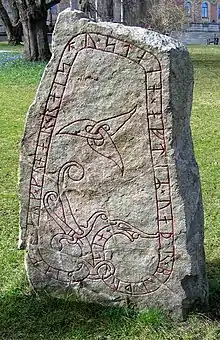 Triquetra on one of the Funbo Runestones (11th century), located in the park of Uppsala University.
Triquetra on one of the Funbo Runestones (11th century), located in the park of Uppsala University.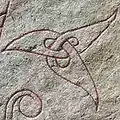 Close-up of a triquetra on one of the Funbo Runestones.
Close-up of a triquetra on one of the Funbo Runestones. Interlaced triquetra on a Norwegian penny minted under Harald Hardrada (r. 1047-1066)
Interlaced triquetra on a Norwegian penny minted under Harald Hardrada (r. 1047-1066)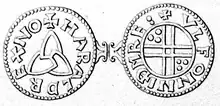 Norwegian penny minted under Harald Hardrada (r. 1047-1066)
Norwegian penny minted under Harald Hardrada (r. 1047-1066)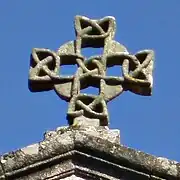 Four triquetras forming a "Carolingian cross" in the church of Santa Susanna in Galicia (11th/12th century?).
Four triquetras forming a "Carolingian cross" in the church of Santa Susanna in Galicia (11th/12th century?).
Variant forms
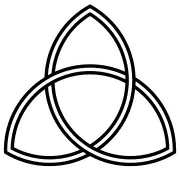 Triquetra composed exactly of three overlapping Vesica piscis symbols.
Triquetra composed exactly of three overlapping Vesica piscis symbols.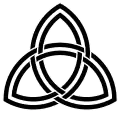 An interlaced double triquetra.
An interlaced double triquetra.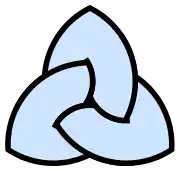 Tightly-knotted form of triquetra.
Tightly-knotted form of triquetra. Triquetra interlaced with circle as Celtic symbol (a "Trinity knot"). (Later adopted by Christian iconography as representative of "the Trinity")
Triquetra interlaced with circle as Celtic symbol (a "Trinity knot"). (Later adopted by Christian iconography as representative of "the Trinity")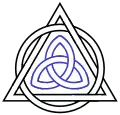 Triquetra in blue as part of an interlaced Celtic decorative symbol. (Later adopted by Christian iconography as representative of "the Trinity")
Triquetra in blue as part of an interlaced Celtic decorative symbol. (Later adopted by Christian iconography as representative of "the Trinity")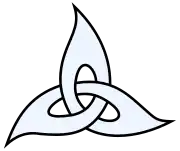 Interlaced triquetra in the style of the Funbo Runestone
Interlaced triquetra in the style of the Funbo Runestone The cross of triquetras, or "Carolingian cross".
The cross of triquetras, or "Carolingian cross".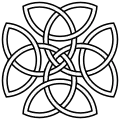 Cross composed of four interlaced triquetras.
Cross composed of four interlaced triquetras.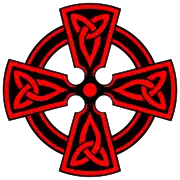 Celtic cross with triquetras.
Celtic cross with triquetras.
See also
References
- ↑ John Burley Waring, Ceramic Art in Remote Ages (1874), 84f.
- 1 2 Tony Abramson (ed.), Two Decades of Discovery Studies in Medieval Coinage 1, Boydell Press (2008), p. 1.
- ↑ "The Corpus of Anglo-Saxon Stone Sculpture". www.ascorpus.ac.uk. Retrieved 16 July 2019.
- ↑ McMahon, Seán (1999). Story of the Claddagh Ring. Mercier Press. ISBN 9781856351898.
- ↑ Mac Mathúna, Liam (1999) "Irish Perceptions of the Cosmos" Celtica vol. 23 (1999), pp.174–187
- ↑ Cunningham, Scott (2004) [1988], "Rune Magic", Wicca: A Guide to the Solitary Practitioner, Woodbury, MN, U.S.A.: Llewellyn, p. 191, ISBN 978-0-87542-118-6.
- ↑ Ross, Dalton; Snetiker, Marc (17 November 2013). "Michonne's Katana". Entertainment Weekly. Retrieved 30 October 2016.
- ↑ Keveney, Bill (12 October 2014). "'The Walking Dead,' up close and personal". USA Today. Retrieved 30 October 2016.
We put a trinity on there – mind, body, soul. That's important to who Michonne (Danai Gurira) is. We put some squares around it. And (executive producer) Robert Kirkman wanted a symbol that was like the biohazard symbol … so we put a triple goddess on there, which looks exactly like it.
- ↑ "Triquetra | Official DARK-Guide Season 1&2 | NETFLIX". DARKNetflix. Retrieved 30 May 2020.
- ↑ "What is the meaning of Triquetra symbol on Mjolnir?". January 2018. Retrieved 8 November 2022.
Further reading
- H. Trætteberg, E. Moltke, I. Lindeberg, "Triquetra" in: Kulturhistorisk leksikon for nordisk middelalder, vol. 18 (1982), p. 634–6356.
- Martin Blindheim: Graffiti in Norwegian stave churches c. 1150 – c. 1350, Oslo 1985, i.a. p. 44–45